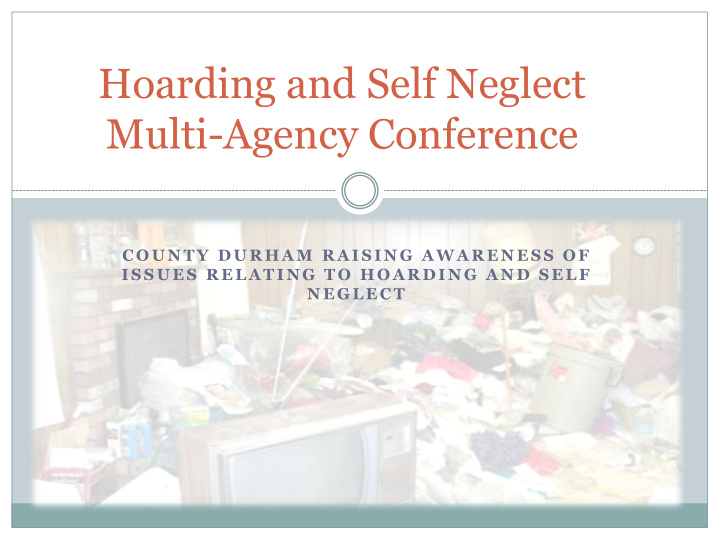



Hoarding and Self Neglect Multi-Agency Conference C O U N T Y D U R H A M R A I S I N G A W A R E N E S S O F I S S U E S R E L A T I N G T O H O A R D I N G A N D S E L F N E G L E C T
Welcome
Agenda Welcome – Colin Steel Introduction – Deborah Barnett What is hoarding? – Deborah Barnett Assessment tools Psychiatric perspective of hoarding – Dr Paul Walker Case studies Health Trainer Workshops: Supporting a person who hoards 1. Fire and fire safety 2. Legal support for those who hoard 3. Housing providers – Practical solutions 4.
Aims and Objectives Objectives For staff to: Aim: To prevent the escalation of To raise awareness of hoarding issues relating to To support the hoarder to hoarding address underlying cases of hoarding To ensure early To support the person to intervention in change hoarding behaviours supporting people who To address risk hoard and / or self To recognise legal neglect frameworks To understand the psychological / mental health issues associated with hoarding
Welcome – Colin Steel (Chief Executive LIVIN) Welcome staff – multi agency event Current position – different responses, require consistent messages Can not wave a miracle wand Support multi agency response with tools New protocol Don’t forget safeguarding responsibilities Celebrate good practice
Introduction to Key Speakers Dr Paul Walker - Psychiatrist Deborah Barnett – Safeguarding and Practice Development (Safeguarding Adults Board / DCC) Helen Matthews - Safeguarding and Practice Development (Safeguarding Adults Board / DCC) Lynne Dolphin – Practice Development ( DCC) Carole Lee – Social Care Direct (DCC) Rachael Swales – LIVIN David Yews – Fire Service Fiona Mawson & Leigh Ann Ramsay - Health Trainer Lorraine Walkden – Homeless Service
What is Hoarding Hoarding is the excessive collection and retention of any material to the point that it impedes day to day functioning (Frost & Gross, 1993). Pathological or compulsive hoarding is a specific type of behaviour characterised by: Acquiring and failing to throw out a large number of items that would appear to hold little or no value and would be considered rubbish by other people. Severe ‘cluttering’ of the person's home so that it is no longer able to function as a viable living space; Significant distress or impairment of work or social life (Kelly 2010).
Break 10.45am – 11am Please return to the main hall
Hoarding Characteristics Fear and anxiety Long term behaviour pattern Excessive attachment to possessions and indecisiveness Unrelenting standards Socially isolated Large number of pets Mentally competent Extreme clutter Self-Care Poor insight
Vulnerability factors Beliefs/attachment Emotional reactions Hoarding behaviour Information processing Perception Attention Clutter Memory Categorisation Decision-making Early experiences Beliefs about possessions Positive emotions Core beliefs: Instrumental value Pleasure unworthy Intrinsic beauty Pride unlovable, helpless Sentimental beauty Acquiring Personality traits Perfectionism Dependency Anxiety, sensitivity Beliefs about vulnerability Paranoia Negative emotions Safety/comfort Mood Sadness/grief Loss Depression Anxiety/fear Beliefs about responsibility Anxiety Guilt/shame Waste Comorbidity Lost opportunity Difficulty Social phobia Beliefs about memory discarding Trauma Mistakes saved items Lost information Beliefs about control FIG 6 A model of compulsive hoarding (from Steketee 2007, reprinted by permission of Oxford University Press, Inc.)
Case example You have multi agency groups on your tables, please use your skills, knowledge and experience to answer the questions regarding the case studies Use your toolkit as a resource Record on flipchart and allocate a person to feedback
Welcome to Health Trainer Social Isolation Poor diet Smoking and fire risk Alcohol and substance misuse Engaging
Workshops 13.00 – 14.00 14.15 – 15.15 Please go straight to your first workshop after lunch as identified on your label. Workshop 1 – Main Auditorium Workshop 2 – Room 1 & 2 Workshop 3 – Conference Room Workshop 4 – Room 5
Lunch 12.15 – 13.00 Please go straight to your first workshop promptly at 13.00 Break at 14.00 for 15 minutes and go straight to your second workshop
Good practice Consider a case of hoarding that a member of your table has come across Describe the case and issues concerned – write down the key points Use the case as a study With a fresh perspective - based on what is written on the paper – what could you do now, working together to support the person: When, who, what, where
Key Messages Using the toolkit Process Mental Health – psychiatric issues and referral to Mental Health Services Legal frameworks Communicating and engaging with someone who hoards Services available – fire service Housing assessment Good practice Now it is down to you to change your practice
Closing comments Thank you to all agencies involved Thank you for all hard work and contributions We appreciate that there are no one size fits all answers, no one service to help, however, we are good at working to solve these difficult problems Please write on post it notes what you have found most useful and stick on flipchart On another post it note identify if there is anything that you would have liked more information on or would have liked to be done differently today Collect certificates on way out
Recommend
More recommend